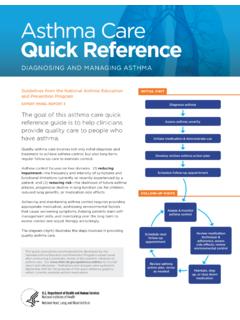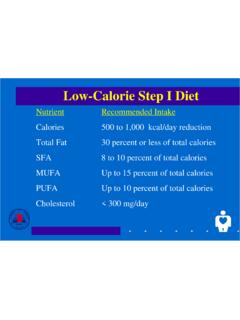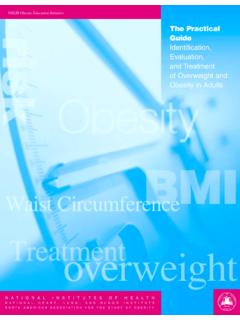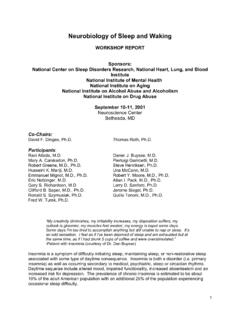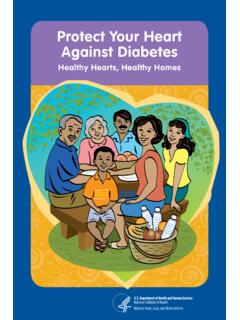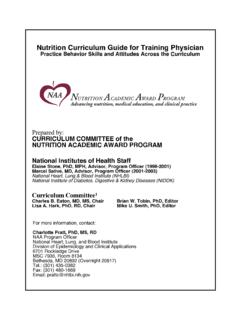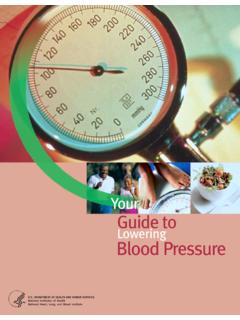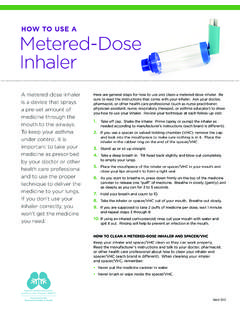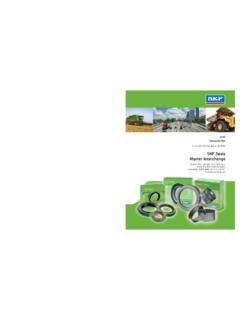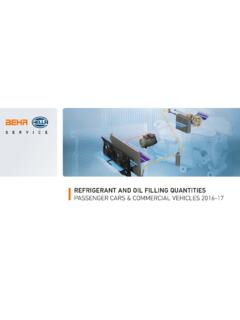Transcription of Expert Panel Report 3: Guidelines for the Diagnosis and ...
1 National Heart, Lung, and Blood Institute National Asthma Education and Prevention Program Expert Panel Report 3: Guidelines for the Diagnosis and Management of Asthma Full Report 2007. August 28, 2007 Contents CONTENTS. Acknowledgements and Financial Disclosures .. xi Acronyms and xix Preface ..xxii Section 1, Introduction ..1. Overall Methods Used To Develop This Report ..2. Systematic Evidence Review Inclusion/Exclusion Search Strategies ..3. Literature Review Preparation of Evidence Ranking the Panel Report Preparation ..8. Section 2, Definition, Pathophysiology and Pathogenesis of Asthma, and Natural History of Asthma ..11. Key Points: Definition, Pathophysiology and Pathogenesis of Asthma, and Natural History of Key Differences From 1997 and 2002 Expert Panel Reports ..12. Introduction ..12. Definition of Asthma.
2 12. Pathophysiology and Pathogenesis of Pathophysiologic Mechanisms in the Development of Airway Inflammation ..16. Inflammatory Inflammatory Mediators ..18. Immunoglobulin Implications of Inflammation for Therapy ..19. Pathogenesis ..20. Host Factors ..20. Environmental Natural History of Asthma ..23. Natural History of Persistent Asthma ..24. Adults ..25. Summary ..27. Effect of Interventions on Natural History of Implications of Current Information About Pathophysiology and Pathogenesis, and Natural History for Asthma Management ..28. i Contents August 28, 2007. Section 3, The Four Components of Asthma Management ..35. Introduction ..35. Section 3, Component 1: Measures of Asthma Assessment and Introduction ..36. Overview of Assessing and Monitoring Asthma Severity, Control, and Responsiveness in Managing Key Points: Overview of Measures of Asthma Assessment and Monitoring.
3 36. Key Differences From 1997 and 2002 Expert Panel Reports ..37. Diagnosis of Asthma ..40. Key Points: Diagnosis of Asthma ..40. Key Differences From 1997 and 2002 Expert Panel Reports ..41. Medical Physical Examination ..42. Pulmonary Function Testing (Spirometry)..43. Differential Diagnosis of Initial Assessment: Characterization of Asthma and Classification of Asthma Key Points: Initial Assessment of Asthma ..47. Key Differences From 1997 and 2002 Expert Panel Reports ..48. Identify Precipitating Factors ..48. Identify Comorbid Conditions That May Aggravate Asthma ..49. Assess the Patient's Knowledge and Skills for Classify Asthma Severity ..49. Assessment of Impairment ..50. Assessment of Risk ..51. Periodic Assessment and Monitoring of Asthma Control Essential for Asthma Management ..52. Key Points: Periodic Assessment of Asthma Key Differences From 1997 and 2002 Expert Panel Reports.
4 54. Goals of Therapy: Asthma Asthma Measures for Periodic Assessment and Monitoring of Asthma Control ..56. Monitoring Signs and Symptoms of Asthma ..57. Monitoring Pulmonary Function ..58. Spirometry ..58. Peak Flow Monitoring ..59. Peak Flow Versus Symptom-Based Monitoring Action Plan ..60. Monitoring Quality of Life ..61. Monitoring History of Asthma Exacerbations ..63. Monitoring Pharmacotherapy for Adherence and Potential Side Effects ..63. Monitoring Patient Provider Communication and Patient Satisfaction ..63. Monitoring Asthma Control With Minimally Invasive Markers and Pharmacogenetics in Managing Methods for Periodic Assessment and Monitoring of Asthma Control ..66. Clinician Assessment ..67. Patient Population-Based Assessment ..67. Referral to an Asthma Specialist for Consultation or Comanagement.
5 68. References ..82. ii August 28, 2007 Contents Section 3, Component 2: Education for a Partnership in Asthma Care ..93. Key Points: Education for a Partnership in Asthma Key Points: Provider Education ..95. Key Differences From 1997 and 2002 Expert Panel Reports ..95. Introduction ..96. Asthma Self-Management Education at Multiple Points of Clinic/Office-Based Education ..97. Adults Teach Asthma Self-Management Skills To Promote Asthma Control ..97. Written Asthma Action Plans, Clinician Review, and Self-Monitoring ..98. Patient Provider Partnership ..99. Health Professionals Who Teach Self-Management ..100. Education With Multiple Sessions ..101. Children Teach Asthma Self-Management Skills To Promote Asthma Control .. 101. Emergency Department/Hospital-Based Education ..102. Adults ..102. Emergency Department Asthma Education.
6 103. Hospital-Based Asthma Educational Interventions by Pharmacists .. 106. Educational Interventions in School Settings ..107. Community-Based Asthma Education ..108. Home-Based Interventions ..109. Home-Based Asthma Education for Home-Based Allergen-Control Other Opportunities for Asthma Education .. 111. Education for Children Using Computer-Based Technology .. 111. Education on Tobacco Avoidance for Women Who Are Pregnant and Members of Households With Infants and Young Case Management for High-Risk Patients ..113. Cost-Effectiveness ..114. Tools for Asthma Self-Management ..115. Role of Written Asthma Action Plans for Patients Who Have Asthma .. 115. Role of Peak Flow Goals of Asthma Self-Management Education and Key Educational Messages .. 121. Establish and Maintain a Partnership ..124. Teach Asthma Self-Management.
7 125. Jointly Develop Treatment Assess and Encourage Adherence to Recommended Therapy .. 131. Tailor Education to the Needs of the Individual Patient ..133. Knowledge and Beliefs ..133. Health Literacy ..134. Cultural/Ethnic Maintain the Asthma Education Resources ..140. Provider Methods of Improving Clinician Behaviors .. 141. Implementing Guidelines Recommended Practices .. 141. Communication Techniques ..143. Methods of Improving System Supports .. 144. Clinical Pathways ..144. Clinical Decision Supports ..145. iii Contents August 28, 2007. Section 3, Component 3: Control of Environmental Factors and Comorbid Conditions That Affect Key Points: Control of Environmental Factors and Comorbid Conditions That Affect 165. Key Differences From 1997 Expert Panel Report ..166. Introduction .. 167. Inhalant Allergens.
8 167. Diagnosis Determine Relevant Inhalant Sensitivity ..167. Management Reduce Immunotherapy ..172. Assessment of Devices That May Modify Indoor Air ..174. Occupational Exposures ..175. Irritants ..175. Environmental Tobacco Smoke ..175. Indoor/Outdoor Air Pollution and Formaldehyde and Volatile Organic Gas Stoves and Comorbid Allergic Bronchopulmonary Aspergillosis ..177. Gastroesophageal Reflux Disease ..178. Obesity ..179. Obstructive Sleep Apnea ..179. Rhinitis/Sinusitis ..180. Stress, Depression, and Psychosocial Factors in Asthma ..180. Other Factors .. 181. Medication Sensitivities ..181. Aspirin ..181. Beta-Blockers ..182. Sulfite Sensitivity ..182. Viral Respiratory Bacterial Infections ..183. Influenza Infection ..183. Female Hormones and Asthma ..183. Primary Prevention of Allergic Sensitization and Asthma.
9 184. Section 3, Component 4: Key Points: Medications ..213. Key Differences From 1997 and 2002 Expert Panel Reports ..215. Introduction .. 215. Overview of the Medications ..216. Long-Term Control Medications ..216. Inhaled Corticosteroids ..216. Mechanism ..216. Inhaled Corticosteroid 217. Efficacy of Inhaled Corticosteroids as Compared to Other Long-Term Control Medications as Monotherapy ..217. Efficacy of Inhaled Corticosteroid and Adjunctive Therapy (Combination Therapy) ..217. Dose-Response and Delivery Device .. 218. Variability in Response and Adjustable Dose Safety of Inhaled Corticosteroids ..220. iv August 28, 2007 Contents Key Points: Safety of Inhaled Corticosteroids ..220. Key Points: Inhaled Corticosteroids and Linear Growth in Children ..222. Oral Systemic Corticosteroids ..224. Cromolyn Sodium and Nedocromil.
10 224. Omalizumab ..225. Antibiotics ..226. Others ..226. Leukotriene Modifiers ..227. Inhaled Long-Acting Beta2 -Agonists ..229. Safety of Long-Acting Beta2-Agonists .. 231. Key Points: Safety of Inhaled Long-Acting Beta2-Agonists .. 231. Methylxanthines ..234. Tiotropium Bromide ..235. Quick-Relief Medications ..235. Anticholinergics ..235. Inhaled Short-Acting Beta2-Agonists ..235. Safety of Inhaled Short-Acting Beta2-Agonists ..236. Key Points: Safety of Inhaled Short-Acting 236. Systemic Corticosteroids ..237. Route of Administration ..238. Alternatives to CFC-Propelled MDIs ..238. Spacers and Valved Holding Chambers .. 239. Complementary and Alternative Medicine ..240. Key Points: Complementary and Alternative Medicine ..240. Acupuncture ..240. Chiropractic Therapy ..241. Homeopathy and Herbal Breathing Relaxation Techniques.
